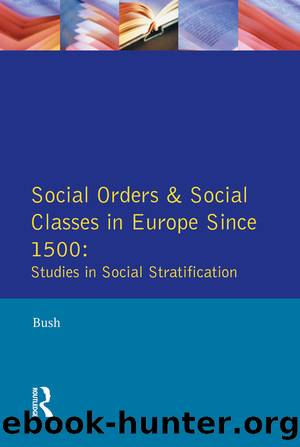Social Orders and Social Classes in Europe Since 1500 by M. L. Bush

Author:M. L. Bush [Bush, M. L.]
Language: eng
Format: epub
ISBN: 9780582083431
Google: ndgFBAAAQBAJ
Barnesnoble:
Publisher: Taylor & Francis
Published: 1992-01-20T00:00:00+00:00
1 Williams Keywords: a Vocabulary of Culture and Society (London, 1976), p. 37.
2 On shifting usages of âbourgeoisâ in France, see M. Vovelle and D. Roche, âBourgeois, rentiers, and property owners: elements for defining a social category at the end of the eighteenth centuryâ, in J. Kaplow (ed.) New Perspectives on the French Revolution: Readings in Historical Sociology (New York, 1965), pp. 25â7.
3 For discussion of the âmiddle classâ within the class structure of contemporary societies, see N. Abercrombie and J. Urry, Capital, Labour and the Middle Classes (London, 1983), and R. Carter, Capitalism, Class Conflict and the New Middle Class (London, 1985).
4 For accounts of the language of class in this period, see A. Briggs, âThe Language of class in early nineteenth-century Englandâ, in A. Briggs and J. Saville (eds.) Essays in Labour History (London, 1960); S. Wallech, âClass versus rank: the transformation of eighteenth-century English social terms and theories of productionâ, Journal of the History of Ideas 47 (1986).
5 See G. Holmes, âGregory King and the social structure of pre-industrial Englandâ, Transactions of the Royal Historical Society 5th series, 27. (1977); P. Mathias, âThe social structure in the eighteenth century: a calculation by Joseph Massieâ, in Mathias, The Transformation of England: Essays in the Economic and Social History of England in the Eighteenth Century (London, 1979); H. Perkin, The Origins of Modern English Society, 1780â1800 (London, 1969), ch. 2.
6 Perkin, op. rit.
7 See the discussion in P.J. Corfield and S. Kelly, âGiving directions to the town: the early town directoriesâ, Urban History Yearbook, 1984: 22â35.
8 S. Nenadic, âRecord linkage and the exploration of nineteenth-century social groups: a methodological perspective on the Glasgow middle class in 1861â, Urban History Yearbook 1987: 34.
9 The Merchant and Manufacturers Magazine of Trade and Commerce (1785): 135.
10 R.Q. Gray, The Labour Aristocracy in Victorian Edinburgh (Oxford, 1976), p. 191.
11 See T. R. Gourvish, âThe rise of the professionsâ in R.G. Gourvish and A. OâDay (eds.) Later Victorian Britain 1867â1900 (London, 1988), pp. 18â19.
12 See E. Higgs, Making Sense of the Census: The Manuscript Returns for England and Wales, 1801â1901 (Public Record Office Handbook 23, 1989).
13 On impoverished medical men see e.g. H. Marland, Medicine and Society in Wakefield and Huddersfield, 1780â1870 (Cambridge, 1987), esp. ch. 7.
14 Quoted in D. Lockwood, The Blackcoated Worker: A Study in Class Consciousness (2nd ed. Oxford, 1989), p. 26.
15 This material comes from the Pease Papers in the Wilberforce House Museum, Hull.
16 The most detailed account of the Losh family is in H. Lonsdale, The Worthies of Cumberland (London, 1873), vol. IV, esp. pp. 186â96.
17 For Henry, see W.V. Farrah, K. Farrah and E.L. Scott, âThe Henrys of Manchesterâ, in Ambix: Journal of Alchemy and Early Chemistry, 12 (1974), nos. 2 and 3.
18 Quoted in P. Earle, The World of Defoe (London, 1976), p. 166.
19 The best account of middle-class living standards remains J. A. Banks, Prosperity and Parenthood: A Study of Family Planning among the Victorian Middle Classes (London, 1954).
20 See H. Perkin, The Rise of Professional Society: England since 1880 (London, 1989), pp.
Download
This site does not store any files on its server. We only index and link to content provided by other sites. Please contact the content providers to delete copyright contents if any and email us, we'll remove relevant links or contents immediately.
Vicious, Elegant Bastards by Hyams Jacky;(183)
A Preface to Politics by Walter Lippmann(122)
Tales from Two Cities by Dervla Murphy(111)
On the Burning of Books by Kenneth Baker(111)
Empires of Panic by Robert Peckham(107)
Simple Living in History by Various Authors Samuel Alexander Amanda McLeod(79)
Mobility and Biography by Sarah Panter(73)
Stories from the Serat Centhini by Santoso Soewito;Pringgoharjono Kestity;(73)
The Oxford Illustrated History of Science by Iwan Rhys Morus(71)
Social Orders and Social Classes in Europe Since 1500 by M. L. Bush(70)
Convict Orphans by Lucy Frost(65)
Tunes on a Penny Whistle: A Derbyshire Childhood by Doris E Coates(60)
Louisiana's Sacred Places by Deborah Burst(51)
Peasants Making History: Living In an English Region 1200-1540 by Christopher Dyer(26)
Volatilization of oxides during oxidation of some superalloys at 1200°C by Unknown(26)
